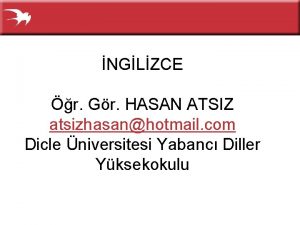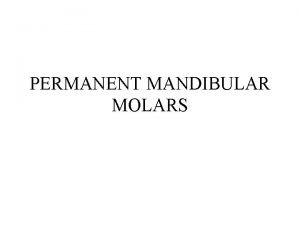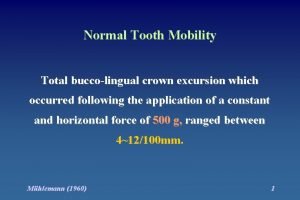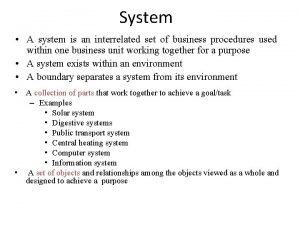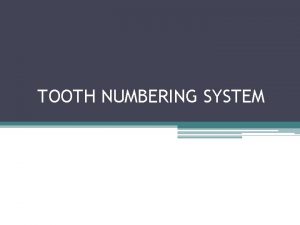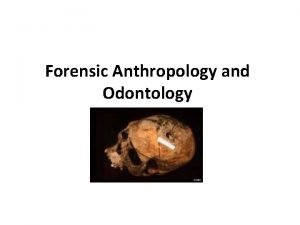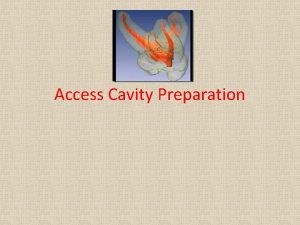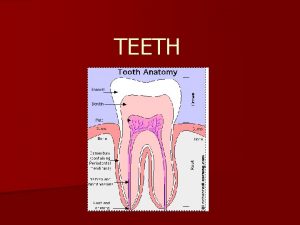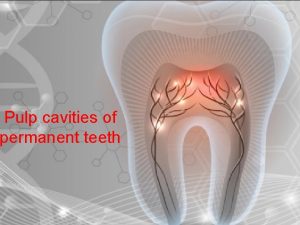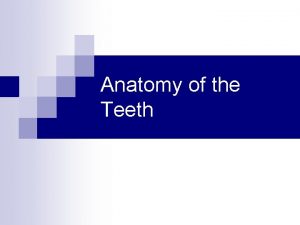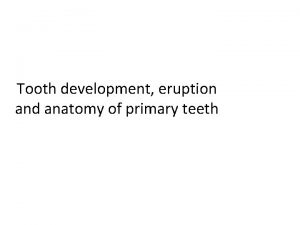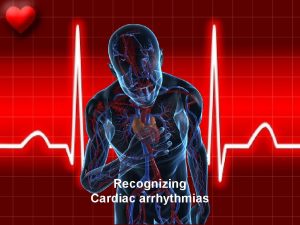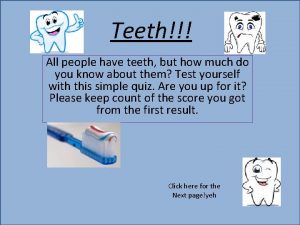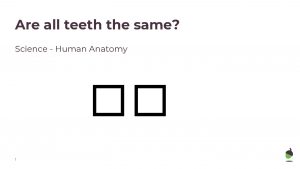Normal tooth anatomy All human teeth are composed












- Slides: 12

Normal tooth anatomy All human teeth are composed of three structural layers: 1 -The outer layer of enamel is an extremely hard, highly mineralized, crystalline structure that covers and protects the crown of the tooth. 2 -The core structure of the tooth is composed of dentine. 3 -At the center of the tooth is the pulp chamber, which contains blood vessels and nerves that connect to the jaw's vascular and nervous supply through the tooth apices. tooth roots are attached to the surrounding alveolar bone of the tooth socket via the periodontal ligament.

Bacterial infection caused by dental caries is the most common cause of pulpal disease Pulpitis – an infection of the pulp Periapical infection (apical periodontitis): • which is inflammation around the apex of th tooth (periapical tissues).

Microorganisms may gain access to the pulp: • through an open cavity due to destruction of both enamel and dentin • through exposed dentin tubules • by direct invasion from a periodontal pocket • by spread of a periapical infection from an adjacent infected tooth • by organisms that gain access to the pulp from the bloodstream.

Microorganisms Associated with Pulp (Root Canal) Infections Obligate anaerobes predominate • Black-pigmenting bacteria species – Prevotella intermedia – Porphyromonas endodontalis – Porphyromonas gingivalis

Pathways for the Infection of Pulp and Periapical Tissues

Pulpitis (infection of the pulp) Caries is initially asymptomatic. Pain does not occur until the decay impinges on the pulp, and an inflammatory process develops. Reversible pulpitis is mild inflammation of the tooth pulp caused by caries encroaching on the pulp. Pain is triggered by hot, cold, and sweet stimuli, lasts for a few seconds, and resolves spontaneously. Treatment involves removal of the carious tissue and placement of a dental restoration, or filling. Irreversible pulpitis, a severe inflammation of the pulp Pain becomes severe, spontaneous, and persistent, and is often poorly localized. The only way to definitively treat the discomfort is root canal treatment (removal of the pulp and filling of the empty pulp chamber and canal) or extraction of the tooth.

Apical periodontitis (inflammation around the apex of the tooth) A severely inflamed pulp will eventually necrose, Pain is severe, spontaneous, and persistent, but unlike that of irreversible pulpitis, localizes to the affected tooth. The tooth is sensitive to percussion with a metal object. Regional lymphadenopathy can be present. Management is root canal treatment or extraction. Antibiotics are not necessary. Apical periodontitis

Apical abscess is a localized, purulent form of apical periodontitis. -Present clinically as a fluctuant buccal or palatal swelling, with or without a draining pus. -Regional adenopathy is usually present. -If pus is draining, pain usually is not severe. -Antibiotics are not necessary unless concurrent cellulitis is present. -Acute incision and drainage of a fluctuant area is needed. -Definitive therapy is root canal treatment or extraction. Apical abscess

Periapical Abscess face is swollen and the eye is swollen shut. This represents a serious, & potentially life threatening infection

Cellulitis Follow apical periodontitis if the infection spreads into the surrounding tissues. Diffuse, tense, painful swelling of the affected tissues occurs. Regional lymphadenopathy is common, and fever may be present. The infection can spread into the major fascial spaces of the head and neck , with the risk of airway compromise. (Ludwig’s angina ) Maxillary infection also may spread to the periorbital area, increasing the risk of serious complications that include loss of vision, cavernous sinus thrombosis, and central nervous system involvement. Cellulitis

Acute Osteomyelitis: infection of jaw bone may result from untreated pulpal and/or periapical infection. is a very serious condition that can cause destruction of large sections of the jaw and be difficult to cure.

Endodontics (Root Canal Therapy) During root canal treatment: the infected pulp is removed therefore eliminating the source of infection. After the pulp is removed and tooth is thoroughly cleaned, the space in the chamber and roots is filled and sealed off to prevent any further leakage or infection development.
 Insidan region jh
Insidan region jh An eye for an eye a tooth for a tooth sister act
An eye for an eye a tooth for a tooth sister act Foot feet tooth teeth
Foot feet tooth teeth Man men woman women
Man men woman women Hasan atsız ingilizce
Hasan atsız ingilizce Occlusal anatomy of teeth
Occlusal anatomy of teeth Excursion dental
Excursion dental A project is an interrelated set of activities
A project is an interrelated set of activities All life is composed of matter
All life is composed of matter Name
Name Teeth numbering systems
Teeth numbering systems How many teeth does a human have
How many teeth does a human have Upper premolar access cavity
Upper premolar access cavity




